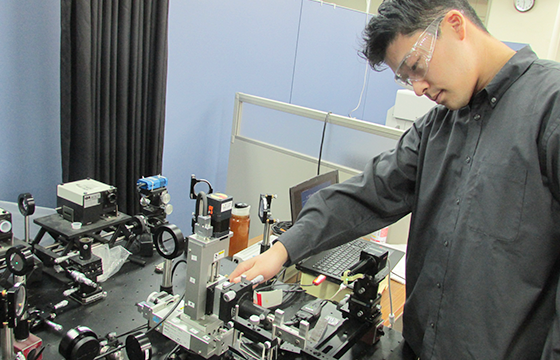Faculty of Engineering, Electronic and Information Engineering

Faculty of Engineering, Electronic and Information Engineering
A fourth-year student Faculty of Engineering Department of Electronics,Information and Communication Engineering (Kusaba Laboratory) who graduated in March has been awarded the 2023 Outstanding Paper Presentation Award (Fundamentals, Materials and Common Division Award) from the Institute of Electrical Engineers of Japan.
This award is given to the presenter of excellent research presented at the national convention of IEEJ, the federation of chapters, and the divisional research meetings in 2023. Faculty of Engineering Department of Electronics,Information and Communication Engineering Kenta Hirai, a fourth-year student in the Optical Information Science Laboratory (Kusaba Laboratory), who graduated in March, presented "Laser Wavelength Dependence of Laser-Induced Nanodot Structures on Silicon Solar Cells" at the IEEJ Optical Application and Vision Workshop held on December 22, 2023, at the Shonan Campus of Tokai University. The research was selected for "Laser Wavelength Dependence of Laser-Induced Nanodot Structures on Silicon Solar Cells," which was presented by Kenta Hirai, a fourth-year student in Kusaba Laboratory. In addition to Dr. Hirai, Tomoyo Tanaka and Daisuke Tsutsumi have been working on this research independently as their graduation research, and Dr. Hirai presented the results as a speaker.
Hirai succeeded in forming nanodot structures (dot-shaped structures of nanometer (one billionth of a meter) size) smaller than the laser wavelength (below the diffraction limit) on the surface of a silicon solar cell, and found that this resulted in the reflectance of the surface of the silicon solar cell reaching several percent and the band gap of the solar cell being increased.

Tsutsumi conducted a detailed investigation into the dependence of the density distribution and shape/size distribution of the nanodot structures on the laser fluence (laser energy density per pulse) and laser wavelength, providing guidelines for the conditions for forming high-density dot structures.

Tanaka used a Raman microscope to investigate the crystallinity of silicon solar cells with nanodot structures formed on them, and discovered that by forming nanodot structures on the surface of a solar cell, compressive residual stress can be imparted while maintaining the crystallinity.

The results of the three researchers' research will lead to anti-reflection of solar cell surfaces and band gap control, which will lead to the development of highly efficient silicon solar cells. It is expected that this will contribute to the fight against global warming and make a major contribution to semiconductor development.
The results of this research have led to patent applications and joint research with national research institutes, making a significant contribution to the university (President's Award). In addition, Hirai, Tanaka, and Tsutsumi have jointly submitted a paper to a British scientific journal, further developing the content presented at the Institute of Electrical Engineers of Japan.
Hirai, Tanaka, and Tsutsumi said, "Regarding the research presentation, it is a rare opportunity to present the results of your research outside of university (at a conference), so I actively tried it. I didn't realize it at all while I was working on my graduation research, but when I heard that I would actually be recognized, I felt that my research results had contributed to society, and I was very satisfied. I am the type of person who pays attention to small details, so I think that the fact that it suited the research theme led to my success."
The award will be presented during the 2024 Fundamentals, Materials, and Commons Division Conference of the Institute of Electrical Engineers of Japan, to be held at Ehime University Johoku Campus (Matsuyama City, Ehime Prefecture) from September 2 to 4, 2024.
*These students were also recently awarded the President's Commendation.